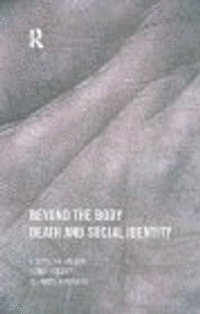

![]()
![]()

If we take the example of the relationship between the self and the ageing body, the concept of embodied agency 'marginalises those members of society who may be physically alive yet socially dead, and those biologically deceased who nevertheless retain an influential social presence in the lives of others.' (ix) Concerning the living whose bodies are deteriorating through the biological processes of ageing, we need to know much more about how 'the life' of someone who has dementia or is brain-dead 'may be constituted, both culturally and socially.' (8) The relationship between the ageing body and the self 'remains elusive' (207) and the authors list three possible interpretations: (1) does 'later life embodiment' result in 'a final intense period of "enselvement"?'; (2) is it characterised by the mask of ageing or 'bodily objectification, the younger self remaining alive in memory behind the "mask" of ageing.'; (3) does a form of psychic death occur which 'empties the object/body of the self? (207) Concerning the transition from life to death, the aged body is 'as a site of tension within which competing representations and practices seek to claim ascendancy.' (44) Issues of power become increasingly salient as the body ages (especially within institutional care) when a contest emerges between ageist images and attitudes towards later life and the knowledge from research findings that older people struggle to maintain a sense of selfhood using other skills than those privileged in forms of more youthful interaction. These include feelings of rhythm and touch , emotions and other modes of self expression other than the privileged form of rational verbal interaction.
Thus Chapter 8, Married Life After Death., examines the question of the persistence of married life after the death of the spouse. The data, derived from in-depth interviews with older widows in London 1993-4, show that death may not bring the social being to an end: 'Older widows and widowers…may continue to enjoy significant social relationships with their "dead" spouse.' (143) Here, again, the authors critique the fashionable model of physically embodied agency and propose a model which goes beyond the belief that the dead only survive socially as 'memories locked within the imaginations of others.' (146) They reject, in other words, 'the empiricist, materialist models which lie at the core of Western thought and experience.' (146) Social life can continue without the living biological presence of significant persons: 'The extent to which the dead make themselves felt by the living depends in part on the degree to which the living invite them to do so.' (149) Unlike spiritualism and clairvoyance, involving a living intermediary, the subject of Chapter 10, the communication of widows with their deceased spouses was unmediated and spontaneous: 'a mundane series of taken-for-granted interactions, remarkable only to the extent to which they reflected "normal" social relationships.' (150)
Beyond The Body is a refreshing defence of disembodiment. Drawing on a wealth of historical and contemporary data integrated within a bold conceptual framework, this book leads us into territory hitherto largely neglected by less imaginative sociologists of the body. As such it is a courageous and stimulating venture, deserving of a place in the curriculum of every course.
Mike Hepworth
University of Aberdeen